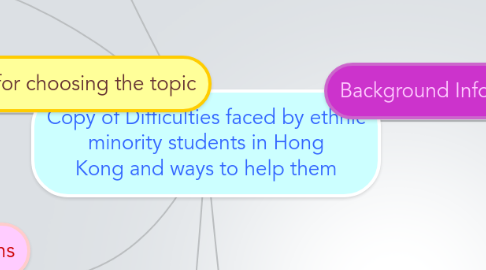
1. Stakeholders involved
1.1. Ethnic Minorities
1.2. Local people
1.3. Government
1.4. Schools and teachers
1.5. Non-governmental Organizations
1.6. Business Enterprises
2. Methodology
2.1. Case Study
2.2. Interview
2.3. Content analysis
3. Reasons for choosing the topic
3.1. To find out why the ethnic minorities have disadvantages in studying in Honk Kong, compared to local students.
3.2. To help the ethnic minorities, so that they can study in Hong Kong with no barriers.
4. Focus Questions
4.1. What are the reasons behind the difficulties faced by the ethnic minority students in learning in Hong Kong ?
4.2. What are the difficulties faced by the ethnic minority students ?
4.3. What can be done by the government to provide the ethnic minority students a better environment for learning ?
5. Concepts involved
5.1. Quality of life
5.1.1. Cultural
5.1.2. Social
5.1.3. Education
5.1.4. Equality
5.2. Discrimination
5.2.1. Racism
5.2.2. Linguistics
5.3. Difference
5.3.1. Cultural
5.3.2. Language
5.4. Social Mobility
6. Background Information
6.1. Current Policy
6.1.1. The Education Bureau assigned some "designated schools" for the ethnic minority students to study in.
6.1.2. Although ethnic minority students are better at English, compared with most local students; they perform poorly in subjects taught in Chinese, and are not qualify for those more popular schools. At last most of them go to those "designed schools". Those successfully entered the 'mainstream schools' didn't received enough support.
6.1.3. Most of them go to those "designated schools".
6.1.3.1. Not conducive to integration and not effective learning of Chinese.
6.1.3.2. They are isolated from local community, making it more difficult for they to integrate with rest of the society later on.
6.1.3.3. They didn't perform well in GCSE Chinese exam, affecting their furture career
6.1.3.4. The aim of promoting of integrated education failed
6.1.3.5. * potential of violation of the Race Discrimination Ordinance by racial segregation
6.1.4. Little language and learning support for ethnic minority students
6.1.5. Under the current chinee-based education system, ethnic minoritystudents cannot develop their potential
6.1.6. The policy of assigning "designated school" for ethnic minority students is discriminatory in nature, and promoted segregation rather than integration
6.1.7. Most local schools used Chinese to teach students, as ethnic minority students are less proficient in Chinese, they did not perform well in Chinese as well as other subjects, and resulted in poor academic performance
6.2. Figures
6.2.1. In 2011, only 17 "non-Chinese-speaking students" from public and Direct Subsidy Scheme schools who sat the HK ALevel Examination received admission offers through the Jupas, out of a total of 19210 offers. (according to the report done by the EOC)
6.2.2. In 2006, ethnic minority students accounted for 3.2% of the total student population at pre-primary level; about 1.1% at the Upper Secondary level and only 0.59% at the post-secondary level. (according to the report done by the EOC)
